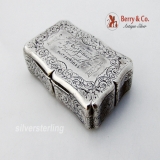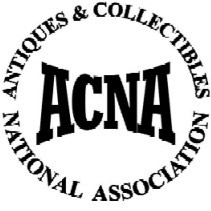Monograms
Joseph Willmore Rackets Snuff Box Thomas Pittman 1844 Sterling Silver

code: wb3192
English sterling silver snuff box by Joseph Willmore having a full set of Birmingham Hallmarks for 1844.
This superb box is for a Rackets or Tennis Match won by Thomas Pittman and is inscribed:
This box was won by Mr. Thos. Pittman in his 48th year of age at Birmingham Oct 28th 1844.
The inscription on the lid has a wide border of Rocaille scroll, foliate and shell decorations.
The bottom of the box has an acid etched scene of two tennis players surrounding a scrolling shield shaped cartouche with the monogram TP. The players are standing atop a banner which reads: Exercitatione Vires Datur or Exercise Gives Strength. There is a wide border of decorations matching those on the lid, with the sides being decorated similarly.
The decorations show the expected wear from use, but the box is free from any damage, having a clean tight hinge. It opens and closes properly.
Joseph Willmore is described by Eric Delieb (Silver Boxes) as "a superlative silversmith, who worked in the trade for almost half a century".
The following is taken from Eustace Hamilton Miles - 1903 - Rackets (Game) - Chapter XLIII
The early players of Racquets were chiefly English, and for the most part cricketers: at least the amateurs were.
We may take the professionals first, and we may follow in outline the account given in the Badminton volume, to which account we should add the name of George Smale, of Wellington College (as one of the greatest teachers of play, and as one of the greatest players of the Open-Court game); with some of the veterans, for instance, with Grimason of Eton, and Judy Stevens of Harrow.
Among the earliest records we find those of Robert Mackay, in 1820, and of Thomas Pittman, who played in the Belvedere Gardens, Pentonville. In those days there was a special rule in case the ball hit a tree!
Tennis & Rackets Association WORLD SINGLES CHAMPIONSHIP Eleven point games played in 1838, enclosed court used for first time in 1860 Thomas Pittman won the Championship in 1825 and 1834. He was the runner up in 1838.
As far as can be gathered from the scanty records of the game, it was in the year 1820 that it first occurred to anybody, and to Robert Mackay in particular, to think the title of champion racket player worth claiming. And it may have been that Robert was the only person who was of that opinion, for the fact appears to be that nobody was found to gainsay him or to contest the title with him.
Whether Robert died or became unfit or incapable to play is uncertain, but at any rate he did not respond to the challenge of Thomas Pittman, who, on June 26, 1825, was to have played all comers at the Belvedere Gardens, Pentonville, for any sum between 5/. and 500/. The inclemency of the weather caused the postponement of the match, but seemingly Thomas found nobody to meet him when the weather grew fair. It is to be remembered that at this time the open court, without roof or side walls, was the recognized game, and that therefore all fixtures had to be made subject to the fairness of the weather. To the modern player it is curious to read in the conditions of a match, ′If a ball touch a tree and afterwards come into court it is a foul.′ Against such contingencies the modern court conditions need not guard, but that side walls and roof, even of the best, are not an absolute protection against the weather many players can testify, for within the last few years the University contest has more than once been postponed owing to the deluge of rain, which the roof of the match court at Prince′s could not defy, and which flooded the floor, rendering play impossible.
But to resume. Apparently Thomas Pittman abdicated, and John, his brother, reigned in his stead; and he in 1834 put forth a challenge to all the world in general, and to one Lamb, with winged and somewhat offensive words, in particular, to meet him at the Belvedere Gardens to decide the rackets supremacy. But it was not until 1838 that Lamb was sufficiently roused to wait upon Pittman at the Belvedere Gardens. Excitement waxed high. Even the deposit of the stakes was made in the presence of a ′strong muster of lovers of this manly game.′ Guineas to pounds were laid on Pittman. The combatants and spectators were all ready, when down came the rain and the match had to be postponed. On June 10 it came off. The match consisted of the first eight out of fifteen games. True there were only eleven aces in a game, but still it sounds a gigantic undertaking, especially played as it was in the height of summer. Lamb proved victorious by eight games to four, and the writer in ′Bell′s Life′comments on the ′wonderful expertness′ of Lamb and the ′remarkable strength′ of Pittman, which criticisms do not give a very vivid picture of their respective styles. The old-fashioned game as played in the open court was, speaking without disrespect, a slow and a ′lobbing′ game, and probably the modern racket player would have been surprised at the continence of hitting power exercised.
This is an important piece of early tennis history.
The interior is gilt and the box measures 2 7/8" - 1 3/4" , 3/4" deep and it weighs 80 grams or 2.6 ozs. Troy.
Inscribed as described above, the soft, warm, original finish is present, with no buffing or machine polishing.
The excellent original condition and clear detail, with no removals, repairs or alterations, make this an especially attractive offering. There is the expected wear from normal use on the decoration.
Sold

